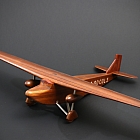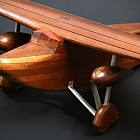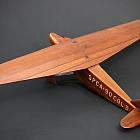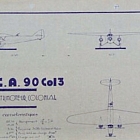




AVION DE SOUFFLERIE SPCA-90 COL3 POLICE COLONIALE Société Provençale Constructions Aéronautiques (SPCA)
Reduct models
The SPCA 90 (or SPCA Type IX) was a three-engined, high-wing monoplane "colonial police" aircraft, designed by the engineer Redon and built in France by the Société provençale de constructions aeronautiques (SPCA) during the intervening period. -wars. It made its first flight on December 8 at Istres in 1932
The narrow framework of the 1930 colonial trimotor program was constantly modified in detail. He engendered for this category of planes, almost similar models. The requirements of the
specification, were a power of 1,000 hp distributed over three engines, the possibility of flying at 2,000 m on only two thrusters, a high wing ensuring good downward visibility, and a metal construction, as a result of the absence of buildings protection in the colonies.
Just like the colonial-type single-engines, the tri-engines of this same type had to be able to fulfill several missions, quite dissimilar to each other. All manufacturers meeting the specification, except Weymann, with its Type 66 twin-boom biplane (CTW-66), presented high-wing monoplanes with fixed conventional gear, equipped with radial engines with air cooling, less heavy and more robust than liquid-cooled ones.
The French state subsidized the studies of thirteen aircraft intended for the Ministry of the Colonies, for a total of more than 36 million francs distributed over nine markets.
Among these prototypes, the studies of the S.P.C.A. 90 (model IX) were financed to the tune of approximately 2,795 million francs.
This tri-engine designed by engineer Redon, was a larger version of the single-engine type 80. Independently of its strictly colonial missions, this aircraft could be used as
troop carrier, with a capacity of fourteen men-at-arms with their equipment, or, in an exclusively medical version, six wounded lying down and four seated.
This well-designed machine was ranked first in the competition and received a maximum of bonuses for its development.
The first flight of the S.P.C.A. 90 was carried out at the beginning of December 1932, in Istres, Bouches-du-Rhône. The aircraft had good flight qualities and remained stable, controls in neutral, at all speeds. He was
registered F-AKF], then was conveyed to the base of Vélizy-Villacoublay, suburb of Paris, at the end of April 1933. It was received by the Technical Service of Aeronautics (STAé) of the French government, for the tests, at the beginning the following May, then was transferred to the GAN (New Aircraft Group), for further testing.
The aircraft's radial engines were fitted with Townend rings to reduce drag, and in September 1933 a new series of trials was begun, with official pilots Barrucand and Bogard at the controls.
Also, at the end of 1933, the aircraft was equipped with propeller brakes
Messier intended for use in the event of an engine failure.
In January 1934, during a test flight with Lieutenant Jacques Lecarme at the controls, accompanied by the assistant engineer Dufour and the adjuster Martin, the aircraft suffered a rupture of the
engine mounts, right side.
The assembly pivoted around its vertical axis, and the propeller came to position itself backwards, destroying several frames of the fuselage. All the people on board left the plane, with the exception of the pilot who managed to bring the plane back to the ground. Failure of the engine mount could have resulted in wing failure and subsequent loss of the machine, but the plan's box structure showed its sturdiness.
This incident provided proof of the solidity of the construction due to the engineer Redon. The thruster mounts were reinforced and a new rudder, trimmed (by a Flettner-type flap), was fitted, and the S.P.C.A. 90 were taken back at the end of April 1934, at the CEMA (Aerial Equipment Test Center, an organization succeeding the STAé and the GAN), before being stored in a hangar.
Finally, this successful trimotor was not ordered for a series production, like besides all the other models of the colonial type. It was used for a while as a general-purpose aircraft in Vélizy-Villacoublay, then was retired.
Among the builders of three-engined aircraft of the colonial type, we found Bernard (Bernard 160/161), Bloch (Bloch MB-71), Dewoitine (Dewoitine D-430), Lorraine-Hanriot (Lorraine-Hanriot LH-70),
Nieuport-Delage (Nieuport-Delage NiD-590), Potez (Potez 400/402), Romano (Romano R-6/R-60) and the S.P.C.A.
The colonial aircraft program, which was a financial mismanagement and was at the origin of a scandal at the time, was stopped dead in September 1934 by the leaders of the French air force.
These search criteria may interest you:
ART DECOREDUCT MODELSAIRPLANE AND AEROSTAAERONAUTICRETROMOBILE SHOW FEBRUARY 2025OBJECTS OF AERONAUTICSART DECO OBJECTSFOCUS




WWW.MASTERPOSTERS.COM
By ESTAMPE MODERNE & SPORTIVE
7 RUE MILTON - 16 RUE CHORON 75009 PARIS
(+33) (0)1 42 80 01 03








